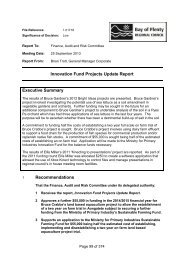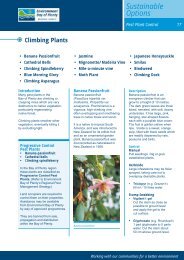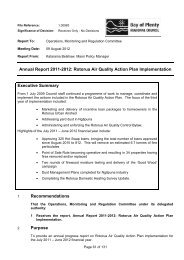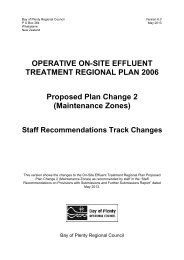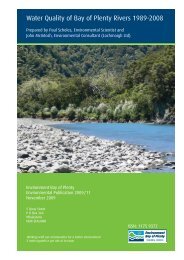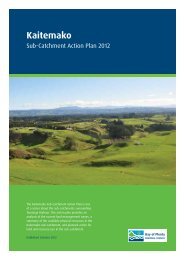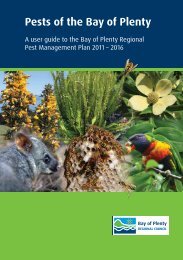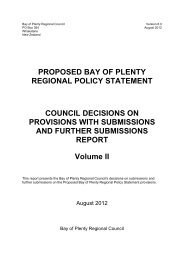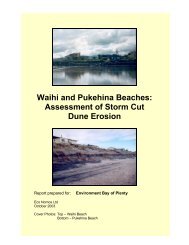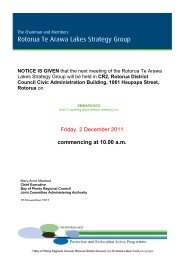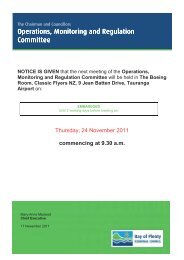Odour Threshold Investigation 2012 - Bay of Plenty Regional Council
Odour Threshold Investigation 2012 - Bay of Plenty Regional Council
Odour Threshold Investigation 2012 - Bay of Plenty Regional Council
Create successful ePaper yourself
Turn your PDF publications into a flip-book with our unique Google optimized e-Paper software.
The results generated by the olfactometer provide an odour measurement in odour<br />
units (ou), based on the extent <strong>of</strong> dilution that resulted in 50% <strong>of</strong> the panel being<br />
able to positively identify an odour. Dividing the known volume concentration <strong>of</strong> the<br />
odorous gas by its measured odour concentration (ou), gives the odour threshold in<br />
parts per billion (ppb).<br />
6.3 Specific aspects <strong>of</strong> the methodology relevant to this study<br />
The following aspects <strong>of</strong> the standard methodology were specifically adopted and/or<br />
modified for this study:<br />
• AS/NZS4323.3 was followed, except in the areas <strong>of</strong> assessor selection and<br />
calibration, and testing room air quality.<br />
• Assessors <strong>of</strong> all ages and both sexes were used in the study.<br />
• The assessors received minimal training only, sufficient to participate in the<br />
olfactometry testing. They were not pre-screened using n-butanol over a three<br />
non-consecutive day period, and nor were any people eliminated from the<br />
study on the basis <strong>of</strong> abnormal sensitivity (or non-sensitivity) to odour, as<br />
required by AS/NZS4323.3.<br />
• Competitive behaviour within each assessor panel was strongly discouraged.<br />
A relaxed environment in the lab was encouraged, and assessors were<br />
encouraged to talk freely (except about the testing) and not necessarily focus<br />
entirely on the testing.<br />
• H 2 S samples were interspersed with n-butanol samples, so as to minimise<br />
repetition and prevent the assessors ‘looking’ specifically for H 2 S.<br />
• The air quality in the testing room was not treated in any way to remove<br />
odours. This was driven largely by practical considerations but has special<br />
significance for some <strong>of</strong> the Rotorua results (see section 7.1.2).<br />
• As required by the Standard, the TOU olfactometer is calibrated annually. This<br />
calibration was last done in August 2011.<br />
• A Jerome 631-X H 2 S analyser 74 capable <strong>of</strong> quantifying H 2 S in the range 2 to<br />
50 ppm was used to measure concentration in every sample tested and for<br />
monitoring ambient concentrations throughout this study.<br />
6.4 Study locations<br />
The Whakatāne session was held between 19 – 23 March using the West Wing <strong>of</strong><br />
the BOPRC Whakatāne <strong>of</strong>fice (NZMG 2861631E 6353571N). Testing in Rotorua<br />
was initially in Scott Street at the old Department <strong>of</strong> Conservation Offices (NZMG<br />
2795999E 6333462N) on 26 March, but due to elevated room temperatures and<br />
ingress <strong>of</strong> ambient H 2 S, the testing was transferred to the Rotorua District <strong>Council</strong><br />
Redwood Information Centre located in the Redwood Reserve on the edge <strong>of</strong> the<br />
city (NZMG 2796903E 6333228N). Testing in this latter location ran from 27 to<br />
30 March.<br />
74 http://www.azic.com/downloads/brochures/Jerome®%20631%20Brochure.pdf<br />
28 Environmental Publication <strong>2012</strong>/06–A review <strong>of</strong> odour properties <strong>of</strong> H 2 S <strong>Odour</strong> <strong>Threshold</strong> <strong>Investigation</strong> <strong>2012</strong>



